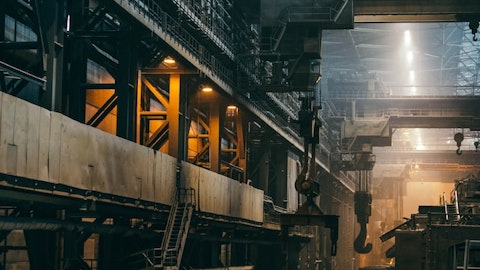Celso Goncalves: Yes, 2025 at
Carlos De Alba: Okay. And then my second question, if I may, on prices. The October renegotiation for the auto — resetting for the auto contracts. How should we think about that? Is that going to be in line with what we saw in April? Or is that more subject to supply demand conditions of the auto sector, not necessarily the HRC spot market?
Lourenco Goncalves: Yes. The HRC spot calls has been taken out of the picture in automotive. I gave each one of our major clients the option to buy from people that sell based on that, no one took it. So we — now we are in supply and demand in a true relationship type of thing. That’s — I know it’s a game changer. Yes, it is a game changer, never happened between steel companies and car manufacturers ever. It’s happening now. I believe that the automotive company’s relationship with the steel mills are at the core of why we are a small iron ore company, we were able to acquire 2 big suppliers of automotive steel that are actually already consolidated from several others that went down throughout the history of this business in the United States.
That party is over. Now we will continue to support the automotive industry. We will continue to provide them the technical capabilities that they need. We will continue to develop the products for the next-generation cars as we normally do, but we want to be rewarded on behalf of our shareholders, we need to get paid. They understood that through the last 2 cycles of negotiation. So when October comes, we’ll talk again. It’s too early. I’ll get my shoes off when I get to the river. Not there yet.
Operator: Our next questions come from the line of Curt Woodworth with Credit Suisse.
Curtis Woodworth: Yes. So I guess with respect to the longer-term CapEx projections, around the $700 million. You also talked about potential investments in CCS as well as iron reduction via hydrogen, which some of the numbers being postulated on some of those things are fairly significant capital. So I realize it may be preliminary, but can you give us a little bit of insight into how CCS or hydrogen could fit into your business model? And what maybe some of the economics could be around that? .
Lourenco Goncalves: Yes. First indications are showing that particularly CCS could be a very high internal rate of return project based on not only money is available to develop the project with participation of the government, but also tax credit of up to $85 per ton of carbon capture. So this is pretty meaningful, pretty significant. It’s not a short-term deployment of capital, Carlos — Curt. So there is nothing really urgent about executing right now, but these are the numbers that we are working with. As far as hydrogen, we are ready. We are ready to use it. Why is that? Well, we already built the direct reduction plant that can use hydrogen. We just need a pipe with hydrogen to connect to the pipeline that we feed natural gas.
We’re starting reaching natural gas with 1%, then 5% and 10%, we can go up to 60% hydrogen in that plant. So we are ready. We just need the hydrogen. We are working with several, not one, but several different groups to create hydrogen hubs that can bring a cheap and plentiful hydrogen to Toledo and also Cleveland because we actually have the technology of injecting natural gas into blast furnace. I think that in the amounts that we use here in the United States, that’s only one other country in the world that does it’s Russia. So the other suppliers of steel for the automotive industry throughout the entire world, Japan, Korea, Europe, Brazil, they don’t have natural gas available, cheap, plentiful, so they don’t have this technique. And we do.
So like the Russians. So we — in the civilized world, we are the only ones. So as far as car manufacturing, we are already a lot greener than the European, is a lot greater than the Japanese, a lot greener than the Koreans because we inject natural gas. As soon as we enrich natural gas with hydrogen, we’re going to be really green. So — and we were promoting — we are producing massive amounts of automotive steel. We’re not producing press release with brand names. We are supplying the massive tons that the car manufacturers produce. We haven’t seen a press release because we are seeing the massive numbers that we produce every quarter in our financial statements. That’s why you don’t see brand names and press releases.
Curtis Woodworth: Okay. That’s helpful. And then, I guess, second question just on the metallic market. You talked about, I guess, 30 million tons of prime metallic demand in 3 years, up from 20, I think you said today. And obviously, you guys are in a unique position having captive ore. I guess — and you did the large FPT deal. What — what is kind of your strategy going forward to either further leverage your metallic position? Would you look to increase your HBI potential, do you see scope for more consolidation in the scrap market? And kind of how do you see that fitting in? You talked about Burns Harbor up for a reline in ’25, is that capital you would spend? Or would that free up iron ore to potentially further leverage the metallic strategy?
Lourenco Goncalves: Curt, look, I’m very comfortable with our situation right now using our finite resources in Minnesota and Michigan for our own use. We like that. So if we’re trying to ask me if I’m going to build another HBI plant, the answer is no. Why if you get Nashwauk, the answer is still no. Are you considering building HBI to supply other company? No, that horse has departed the barn when I acquired AK Steel. I built that HBI plant to support mini-mills that I thought they were really serious in producing flat-rolled steel with the high specifications. But actually, they are in the business of producing rebar, wide flange beams, plate. That’s all good. Good stuff, but doesn’t compete against my automotive. So I’ll keep my metallic for ourselves.
FPT is the biggest buyer of prime scrap in the country, will continue to do this closed loops. We are happy with what we have. We only continue to grow FPT for ourselves as well. So it’s all self-centered. It’s all in closing side, Cleveland-Cliffs and everybody else will be outside looking.
Operator: Our next questions come from the line of Timna Tanners with Wolfe Research.
Timna Tanners: Wanted to ask a little bit about the mix in my first question. So I know that Lourenco mentioned that the big driver of improved volumes was the automotive market. But based off of the detail that you provided, I couldn’t see a big move in coded. I actually saw the biggest movement in HRC. So I’m just wondering, is there a cadence for maybe that ramps up more later in the year? Or is this kind of the mix that we should expect for the balance of the year?
Lourenco Goncalves: Yes. Look, we did gain hot-rolled as well. Like I said, when you allocate more to automotive and you basically fill up your galvanizing lines producing exposed parts and high strength, low alloys for structure, cages, for EVs, things like that, you are done with your utilization of high value-added galvanized and then you grow shipments, you’re going to grow shipping where it’s easier and it’s easier to sell hot rolled. So your assessment is that on. That’s where the growth came after filling up all of our capacity of galvanized with high value-added governance.
Timna Tanners: Okay. And you’re planning to continue to produce at these levels through the rest of the year, just to my question, I think Nucor mentioned on its call that it was going to manage volumes, and I think other companies have said they’re going to run full out. So just wanted your latest thinking there. .
Lourenco Goncalves: We are running full out to supply our automotive clients. As our automotive clients continue to build more and more cars as the recession has been delayed one more time. And with the Fed getting to the end of this — like I called in my prepared remarks, right, hiking Marathon, we are going to see that cars will continue to be sold. And we are the ones that will benefit the most from that. And with our other capacity allocated to the rest of the market. We are also developing closed loop programs with our major clients in appliance and other markets. So we are continuing to deliver more to these folks. So — we’re in good shape with all that. My perspective for the balance of the year is very positive because it tags along with the growth in demand that’s coming from automotive.
Timna Tanners: Got it. And then if I could, the last question is just on the guidance you gave last quarter was for net periodic benefit credits of $140 million, and you started out a pretty high run rate. So just wondering if you have any updated guidance if we should still be using that value…
Lourenco Goncalves: I’m sorry, Timna, can you repeat the question one more time? I think I missed. .
Timna Tanners: Yes. No problem. Yes. So on the — just a kind of accounting question, I guess, on the net periodic benefit credits, I have in my notes, a $140 million guided for 2023 on the last call, but the first quarter was already $50 million. So just trying to make sure that that’s still the right value for modeling purposes.
Celso Goncalves: Got you. Timna, it’s Celso. Yes, I think you’re missing service cost and interest costs, which are on COGS, that’s to around, call it, $140 million after you consider that piece. It’s still $140 million.
Operator: Our next questions come from the line of Tristan Gresser with BNP Paribas.





